Amrita Sher-Gil
| Amrita Sher-Gil | |
|---|---|
 | |
| Born |
30 January 1913 Budapest, Kingdom of Hungary |
| Died |
5 December 1941 (aged 28) Lahore, British India (today Pakistan) |
| Nationality | Indian |
| Education |
Grande Chaumiere École des Beaux-Arts (1930–34) |
| Known for | painter |
Amrita Sher-Gil (Punjabi: امرِتا شیرگِل, ਅੰਮ੍ਰਿਤਾ ਸ਼ੇਰਗਿੱਲ; 30 January 1913[1] – 5 December 1941) was an eminent Indian painter, sometimes known as India's Frida Kahlo.[2] Born to a Punjabi Sikh father and a Hungarian-Jewish mother, she is today considered an important woman painter of 20th-century India, whose legacy stands on a par with that of the Masters of Bengal Renaissance.[3][4] She is also the "most expensive" woman painter of India.[5]
Early life and education
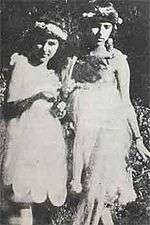

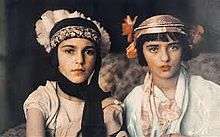
Amrita Sher-Gil was born on 30 January 1913 in Budapest, Hungary,[6] to Umrao Singh Sher-Gil Majithia, a Sikh aristocrat and a scholar in Sanskrit and Persian, and Marie Antoniette Gottesmann, a Hungarian-Jewish opera singer. Her mother came to India as a companion of Princess Bamba Sutherland the granddaughter of Maharaja Ranjit Singh.[7][8] Sher-Gil was the elder of two daughters born. Her younger sister was Indira Sundaram (née Sher-Gil), mother of the contemporary artist Vivan Sundaram. She spent most of early childhood in Budapest. She was the niece of Indologist Ervin Baktay. He guided her by critiquing her work and gave her an academic foundation to grow on. He also instructed her to use servants as models. The memories of these models would eventually lead to her return to India.[9]
In 1921 her family moved to Summer Hill, Shimla in India, and soon began learning piano and violin, and by age nine she along with her younger sister Indira were giving concerts and acting in plays at Shimla's Gaiety Theatre at Mall Road, Shimla.[10] Though she was already painting since the age of five she formally started learning painting at age eight.[10]
In 1923, Marie came to know an Italian sculptor, who was living at Shimla at the time. In 1924, when he returned to Italy, she too moved there along with Amrita and got her enrolled at Santa Annunziata, an art school at Florence. Though Amrita didn't stay at this school for long, and returned to India in 1924, it was here that she was exposed to works of Italian masters.[11]
At sixteen, Sher-Gil sailed to Europe with her mother to train as a painter at Paris, first at the Grande Chaumiere under Pierre Vaillant and Lucien Simon and later at École des Beaux-Arts (1930–34),[12][13] she drew inspiration from European painters such as Paul Cézanne and Paul Gauguin,[14] while coming under the influence of her teacher Lucien Simon and the company of artist friends and lovers like Boris Tazlitsky. Her early paintings display a significant influence of the Western modes of painting, especially as practiced in the Bohemian circles of Paris in the early 1930s. In 1932, she made her first important work, Young Girls, which led to her election as an Associate of the Grand Salon in Paris in 1933, making her the youngest ever[15][16] and the only Asian to have received this recognition.[11]
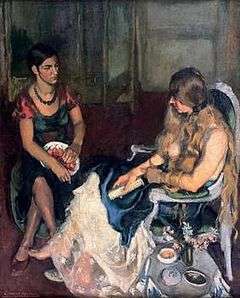
Career
In 1934, while in Europe she "began to be haunted by an intense longing to return to India [...] feeling in some strange way that there lay my destiny as a painter", as she later wrote about her return to India the same year.[17] She began a quest for the rediscovery of the traditions of Indian art which was to continue till her death. In May 1935 in Shimla Amrita met the English journalist Malcolm Muggeridge, then working as Assistant Editor and leader writer for the Calcutta Statesman.[18] Both Malcolm and Amrita stayed at the family home at Summer Hill, Shimla and a short intense affair took place during which she painted a casual portrait of her new lover, the painting now with the National Gallery in New Delhi. By September 1935 Amrita was seeing Muggeridge off as he travelled back to England for new employment, the parting timely and no doubt of relief to them both.[19] She left herself for travel in 1936 at the behest of an art collector and critic, Karl Khandalavala, who encouraged her to pursue her passion for discovering her Indian roots.[14] She was greatly impressed and influenced by the Mughal and Pahari schools of painting and the cave paintings at Ajanta.
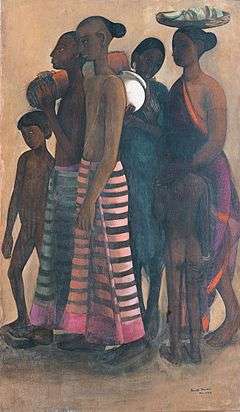
Later in 1937, she toured South India[14] and produced the famous South Indian trilogy of paintings Bride's Toilet, Brahmacharis, and South Indian Villagers Going to Market following her visit to the Ajanta caves, when she made a conscious attempt to return to classical Indian art. These paintings reveal her passionate sense of colour and an equally passionate empathy for her Indian subjects, who are often depicted in their poverty and despair.[20] By now the transformation in her work was complete and she had found her 'artistic mission' which was, according to her, to express the life of Indian people through her canvas.[1] While in Saraya Sher-Gil wrote to a friend thus: "I can only paint in India. Europe belongs to Picasso, Matisse, Braque.... India belongs only to me".[21] Her stay in India marks the beginning of a new phase in her artistic development, one that was distinct from the European phase of the interwar years when her work showed an engagement with the works of Hungarian painters, especially the Nagybanya school of painting.[22]
Sher-Gil married her Hungarian first cousin, Dr. Victor Egan in 1938 and moved with him to India to stay at her paternal family's home in Saraya in Gorakhpur, Uttar Pradesh. Thus began her second phase of painting which equals in its impact on Indian art with the likes of Rabindranath Tagore and Jamini Roy of the Bengal school of art. The 'Calcutta Group' of artists, which transformed the Indian art scene in a big way, was to start only in 1943, and the 'Progressive Artist's Group', with Francis Newton Souza, Ara, Bakre, Gade, M. F. Husain and S. H. Raza among its founders, lay further ahead in 1948.[2][23][24] Amrita's art was strongly influenced by the paintings of the two Tagores, Rabindranath and Abanindranath who were the pioneers of the Bengal School of painting. Her portraits of women resemble works by Rabindranath while the use of 'chiaroscuro' and bright colours reflect the influence of Abanindranath.[25]
It was during her stay at Saraya that she painted the Village Scene, In the Ladies' Enclosure and Siesta all of which portray the leisurely rhythms of life in rural India. Siesta and In the Ladies' Enclosure reflect her experimentation with the miniature school of painting while Village Scene reflects influences of the Pahari school of painting.[26] Although acclaimed by art critics Karl Khandalavala in Bombay and Charles Fabri in Lahore as the greatest painter of the century, Amrita's paintings found few buyers. She travelled across India with her paintings but the Nawab Salar Jung of Hyderabad returned them and the Maharaja of Mysore chose Ravi Varma's paintings over hers.[27]
Although from a family that was closely tied to the British Raj, Amrita herself was a Congress sympathiser. She was attracted to the poor, distressed and the deprived and her paintings of Indian villagers and women are a meditative reflection of their condition. She was also attracted by Gandhi's philosophy and lifestyle. Nehru was charmed by her beauty and talent and when he went to Gorakhpur in October 1940, he visited her at Saraya. Her paintings were at one stage even considered for use in the Congress propaganda for village reconstruction.[21]
In September 1941, Victor and Amrita moved to Lahore, then in undivided India and a major cultural and artistic centre. She lived and painted at 23 Ganga Ram Mansions, The Mall, Lahore where her studio was on the top floor of the townhouse she inhabited. Amrita was known for her many affairs with both men and women[17] and many of the latter she also painted. Her work Two Women is thought to be a painting of herself and her lover Marie Louise.[28]
In 1941, just days before the opening of her first major solo show in Lahore, she became seriously ill and slipped into a coma.[17] She later died around midnight[20] on 6 December 1941, leaving behind a large volume of work. The reason for her death has never been ascertained. A failed abortion and subsequent peritonitis have been suggested as possible causes for her death.[29] Her mother accused her doctor husband Victor of having murdered her. However, the day after her death Britain declared war on Hungary and Victor was sent to jail as a national enemy. Amrita was cremated on 7 December 1941 at Lahore.[27]
Legacy
Sher-Gil's art has influenced generations of Indian artists from Sayed Haider Raza to Arpita Singh and her depiction of the plight of women has made her art a beacon for women at large both in India and abroad.[30] The Government of India has declared her works as National Art Treasures,[2] and most of them are housed in the National Gallery of Modern Art in New Delhi.[31] A postage stamp depicting her painting 'Hill Women' was released in 1978 by India Post,[32] and the Amrita Shergill Marg is a road in Lutyens' Delhi named after her. In 2006, her painting Village Scene sold for ₹6.9 crores at an auction in New Delhi which was at the time the highest amount ever paid for a painting in India.[26]
Besides remaining an inspiration to many a contemporary Indian artists, in 1993, she also became the inspiration behind, the famous Urdu play, by Javed Siddiqi, Tumhari Amrita (1992), starring Shabana Azmi and Farooq Shaikh.[33]
Her work is a key theme in the contemporary Indian novel "Faking It" by Amrita Chowdhury.[34] Aurora Zogoiby, a character in Salman Rushdie's 1995 novel "The Moor's Last Sigh," was inspired by Sher-Gil.[35]
Gallery
-

Self-portrait, 1930
-
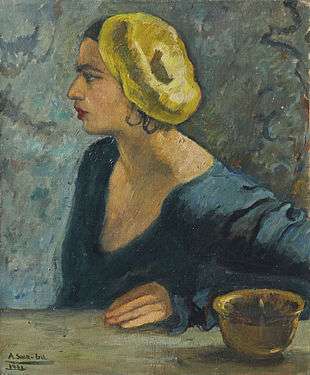
Self-portrait (untitled), 1931
-
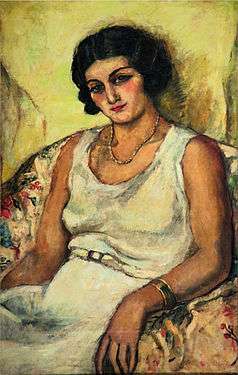
Klarra Szepessy, 1932
-

Hungarian Gypsy Girl, 1932
-
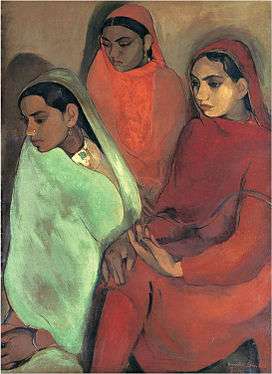
Group of Three Girls, 1935
-

Bride's Toilet, 1937
-
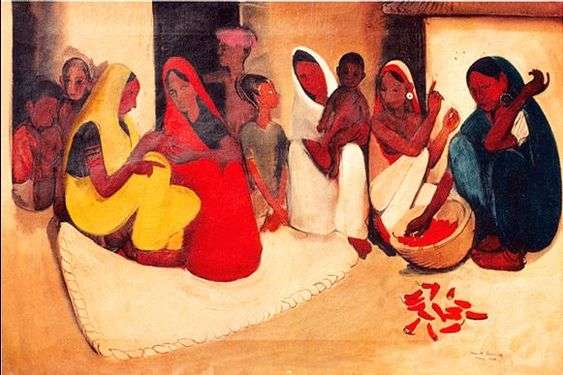
Village Scene, 1938
References
- 1 2 Great Minds, The Tribune, 12 March 2000.
- 1 2 3 Amrita Sher-Gill at. Mapsofindia.com.
- ↑ First Lady of the Modern Canvas Indian Express, 17 October 1999.
- ↑ Women painters at 21stcenturyindianart.com Archived 20 December 2007 at the Wayback Machine.
- ↑ Most expensive Indian artists. Us.rediff.com.
- ↑ "Budapest Diary". Outlook. 20 September 2010. Retrieved 5 February 2013.
- ↑ Kang, Kanwarjit Singh (20 September 2009). "The Princess who died unknown". The Sunday Tribune. Retrieved 13 March 2010.
- ↑ Singh, Khushwant (27 March 2006). "Hamari Amrita". Outlook. Retrieved 5 February 2013.
- ↑ On Amrita Sher-Gil: Claiming a Radiant Legacy By Nilima Sheikh
- 1 2 Amrita Shergill at sikh-heritage. Sikh-heritage.co.uk (30 January 1913).
- 1 2 Amrita Shergill Biography at. Iloveindia.com (6 December 1941).
- ↑ Archives 'Amrita Shergil' project www.hausderkunst.de.
- ↑ Amrita Sher-Gil profile at. Indianartcircle.com.
- 1 2 3 Amrita Sher-Gil Exhibition at tate.orgTemplate:Link updated
- ↑ Works in Focus, Tate Modern, 2007.
- ↑ Amrita Shergil at tate. En.ce.cn.
- 1 2 3 Laid bare – the free spirit of Indian art The Daily Telegraph, 24 February 2007.
- ↑ Bright-Holmes, John (1981). Like It Was: The Diaries of Malcolm Muggeridge. entry dated 18 January 1951: Collins. p. 426. ISBN 978-0-688-00784-3.
- ↑ Wolfe, Gregory (2003). Malcolm Muggeridge: A Biography. page 136-137: Intercollegiate Studies Institute. p. 136. ISBN 1932236066.
- 1 2 Amrita Shergill at. Indiaprofile.com (6 December 1941).
- 1 2 "Amrita's village". Frontline. 30 (04). February–March 2013. Retrieved 26 February 2013.
- ↑ Daily Times, 15 December 2004. Dailytimes.com.pk (15 December 2004).
- ↑ Contemporary Art Movements in India. Contemporaryart-india.com.
- ↑ Indian artists. Art.in.
- ↑ "Art into life". HT Mint. 31 January 2013. Retrieved 6 February 2013.
- 1 2 "White Shadows". Outlook. 20 March 2006. Retrieved 5 February 2013.
- 1 2 "Hamari Amrita". Outlook. 27 March 2006. Retrieved 5 February 2013.
- ↑ "Passion And Precedent". Outlook. 21 December 1998. Retrieved 5 February 2013.
- ↑ Truth, Love and a Little Malice, An Autobiography by Khushwant Singh Penguin, 2003. ISBN 0-14-302957-6.
- ↑ "Sad In Bright Clothes". Outlook. 28 January 2013. Retrieved 5 February 2013.
- ↑ Amrita Sher-Gil at. Culturalindia.net (30 January 1913).
- ↑ Art on Indian Postage Stamps. Indiapicks.com.
- ↑ Digital encounters The Hindu, 13 August 2006]
- ↑ Faking It - Amrita V Chowdhury. Retrieved 5 February 2013.
- ↑ "Amrita Sher-Gil: A Self-Portrait in Letters and Writings", ed. Vivan Sundaram, Tulika Books, 2010
Further reading
- Amrita Sher-Gil, by Karl J. Khandalavala. New Book Co., 1945
- Amrita Sher-Gil: Essays, by Vivan Sundaram, Marg Publications; New Delhi, 1972.
- Amrita Sher-Gil, by Baldoon Dhingra. Lalit Kala Akademi, New Delhi, 1981. ISBN 0-86186-644-4.
- Amrita Sher-Gil and Hungary, by Gyula Wojtilla . Allied Publishers, 1981.
- Amrita Sher-Gill: A Biography by N. Iqbal Singh, Vikas Publishing House Pvt.Ltd., India, 1984. ISBN 0-7069-2474-6
- Amrita Sher-Gil: A personal view, by Ahmad Salim. Istaarah Publications; 1987.
- Amrita Sher-Gil, by Mulk Raj Anand. National Gallery of Modern Art; 1989.
- Amrita Shergil: Amrita Shergil ka Jivan aur Rachana samsar, by Kanhaiyalal Nandan. 2000.
- Re-take of Amrita, by Vivan Sundaram. 2001, Tulika. ISBN 81-85229-49-X
- Amrita Sher Gill – A Painted Life by Geeta Doctor, Rupa 2002, ISBN 81-7167-688-X
- Amrita Sher-Gil: A Life by Yashodhara Dalmia, 2006. ISBN 0-670-05873-4
- Amrita Sher-Gil: An Indian Artist Family of the Twentieth Century, by Vivan Sundaram, 2007, Schirmer/Mosel. ISBN 3-8296-0270-7
- Amrita Sher-Gil: A Self-Portrait in Letters and Writings edited by Vivan Sundaram, Tulika Books, 2010.
- Feminine Fables: Imaging the Indian Woman in Painting, Photography and Cinema, by Geeti Sen, Mapin Publishing, 2002.
- The Art of Amrita Sher-Gil, Series of the Roerich Centre of Art and Culture. Allahabad Block Works, 1943.
- Sher-Gil, by Amrita Sher-Gil, Lalit Kala Akademi, 1965.
- India’s 50 Most Illustrious Women by Indra Gupta ISBN 81-88086-19-3
- Famous Indians of the 20th century by Vishwamitra Sharma. Pustak Mahal, 2003, ISBN 81-223-0829-5
- When was Modernism: Essays on Contemporary Cultural Practice in India, by Geeta Kapur, 2000.
- Rahman, Maseeh (6 October 2014). "In the shadow of death". The Arts. India Today. 39 (40): 68–69.
External links
| Wikiquote has quotations related to: Amrita Sher-Gil |
| Wikimedia Commons has media related to Amrita Sher-Gil. |
Biography
- Amrita Sher-Gil biography, articles and work.
- Amrita-it.com – A Resource site on Amrita Sher-Gil
- Amrita Sher-Gil Bio, Photos and Paintings
- Biography of Artist Amrita Sher-Gil and Photos
Paintings
- Amrita Sher-Gil on Art and appreciation
- Amrita Sher-Gil Gallery of Paintings, Bio, Books, Photos
- Showcase:Amrita Sher-Gil at National Gallery of Modern Art
- A slideshow of Amrita Sher-Gil's painting at Tate Modern
- List of most expensive Indian paintings ever sold
- Amrita Sher-Gil exhibition at Tate Modern, London